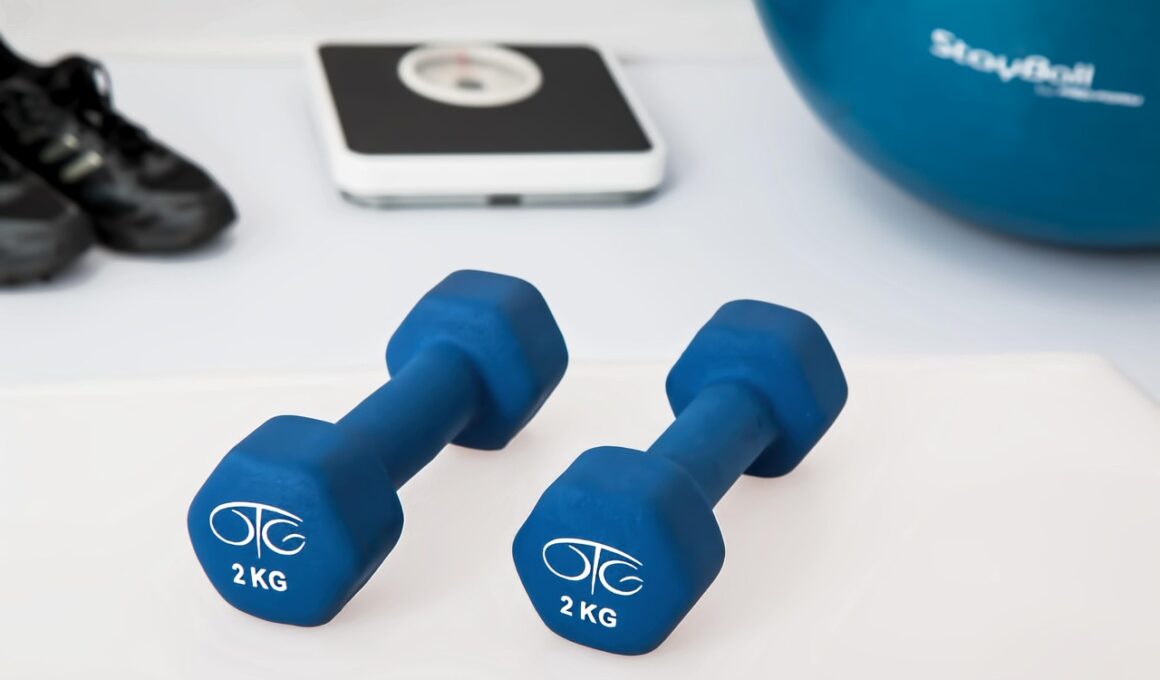How Functional Training Enhances Rehab Outcomes
Functional training plays a vital role in rehabilitation by focusing on exercises that mimic daily activities, essential for patients recovering from injuries. Unlike traditional strength training, functional training emphasizes movement patterns rather than isolated muscle activity. By integrating core stability, flexibility, and coordination, this training modality helps restore movement functionality efficiently. For instance, exercising with stability balls engages multiple muscle groups, enhancing overall strength and stability. Patients also benefit from improved proprioception and balance, which are crucial during rehabilitation. A few functional exercises include squats, lunges, and step-ups, all promoting mobility. Additionally, this type of training can reduce the likelihood of future injuries by improving joint stability and reducing muscle imbalances in affected areas. Functional training’s holistic approach provides a comprehensive method to tailor rehabilitation programs for individual needs. Options range from high-impact activities to gentle movements, accommodating various recovery stages and personal preferences. Through these adaptations, rehab programs remain engaging and effective for many patients. Thus, incorporating functional training can significantly enhance rehabilitation outcomes.
By emphasizing real-life movements, functional training links the gap between exercise and daily tasks, promoting quicker recovery. It encourages active participation, making patients more engaged in their rehab process. Moreover, rehabilitation programs utilizing functional training have been shown to yield better emotional and psychological outcomes as they allow individuals to regain confidence through progressive movement adaptations. Feeling stronger and more agile positively impacts a person’s mental state during challenging recovery periods. For many, returning to previous activity levels is crucial, and functional training provides the tools necessary to facilitate this transition. By involving both physical and psychological dimensions of recovery, patients experience quicker adjustments to rehabilitation protocols. Progressing through movement patterns enhances neuromuscular coordination and contributes to sensible strength building, thereby fostering faster healing. Furthermore, the variability in functional training keeps patients motivated; they can incorporate various activities while meeting their rehabilitation goals. By continually adjusting intensity and complexity, therapists can maintain patient engagement, reducing dropout rates in rehab programs. The personalized nature of functional training significantly contributes to an improved quality of life after injury. In summary, its role in rehab is transformative and essential for holistic recovery.
The Science Behind Functional Training
Functional training relies on exercise science principles and biomechanics to target movements relevant to everyday life. Through these methods, therapists assess individual patient needs and recovery goals. The training paradigm includes exercises that consider specific joint motions and muscle mechanics related to daily activities. Understanding movement patterns is paramount for effective rehabilitation, as it helps therapists develop customized programs. Applying functional training in rehabilitation fosters agility, strength, and flexibility, crucial for athletic recovery and general fitness. Furthermore, research shows that engagement in functional training can contribute to muscle memory, facilitating smooth transitions back to regular activities. Certain exercise modalities also address specific muscular deficiencies that occur during periods of inactivity following injuries. Notably, resistance bands and free weights are commonly used in functional training due to their versatility in targeting multiple muscle groups simultaneously. Integrating these tools helps rehabilitation professionals create diverse training regimens tailored to individual capabilities. While focusing on enhancing key movements relevant to daily tasks, therapists simultaneously track patient progress regularly. In doing so, they can make necessary adjustments based on ongoing assessments, ensuring patients remain on a path toward optimized recovery and improved physical well-being.
Another essential aspect of functional training is its adaptability to various settings and patient populations. Whether in hospitals, clinics, or home environments, functional training exercises can be modified to suit individual circumstances. For instance, elderly patients recovering from surgery may require gentle, low-impact movements while more active individuals may incorporate higher intensity regimens. These variations address personal safety and comfort, allowing clients to progress through recovery at their own pace and in a secure manner. Additionally, functional training fosters independence, empowering individuals to perform tasks with greater ease and confidence. Activities emphasizing balance and coordination not only enhance physical fitness but also foster psychological resilience. By creating opportunities for patients to experience success in their movements, functional training motivates individuals to commit to their rehabilitation journey wholeheartedly. As a result, functional training becomes an invaluable tool for fostering self-esteem and combating feelings of helplessness commonly associated with injury recovery. Clinicians often note that where traditional methods may falter, functional training cultivates a positive environment focused on empowerment and achievement. Ultimately, this dynamic method significantly enhances overall rehab efficacy and patient satisfaction.
Implementation Strategies in Rehab
To implement functional training effectively in rehabilitation practices, healthcare professionals must assess the specific capabilities and limitations of each individual. Conducting thorough evaluations establishes a baseline for appropriate exercise selection, allowing therapists to develop customized training routines. It’s essential for professionals to maintain flexibility in program design, as patient progress can be unpredictable. Consequently, continual assessment of goals ensures that therapy remains relevant and motivating throughout recovery. Collaborative goal setting, where patients are involved in defining their objectives, fosters greater ownership and accountability. This cooperation can further enhance the effectiveness of the rehabilitation process. Moreover, therapists should utilize progress tracking tools, like fitness apps or logs, to document achievements regularly. This data can provide insight into effective practices while also encouraging consistency among patients. Group sessions might be integrated, offering an opportunity for peer support and community engagement as participants work toward shared objectives. The social aspect of training bolsters motivation and commitment, ultimately leading to better outcomes. Continuous education for therapists in the principles of functional training ensures that they remain informed about the latest evidence-based practices for rehabilitation.
One effective method is to integrate functional training principles with traditional rehabilitation techniques, creating a comprehensive approach. Merging strength training with functional tasks enables patients to build muscle while practicing movements relevant to their daily lives. This combination not only strengthens the body but also emphasizes practical applications, seamlessly translating strength gains into functional improvements. To support this blended approach, therapists can employ tools such as balance boards, medicine balls, and resistance bands, which facilitate dynamic movements that challenge balance and stability. By continuously introducing new exercises, therapists can keep sessions fresh and engaging, catering to patients’ progressive abilities. Additionally, many functional movements can become part of home practice, allowing patients the flexibility to continue their training outside clinical settings. These enhancements reinforce therapy while promoting autonomy in recovery goals, decreasing reliance on physiotherapists. The emphasis on functional strength ensures that patients leave the rehabilitation process with renewed confidence in their physical abilities. Beyond physical rehabilitation, functional training provides a framework for promoting overall wellness and preventive care. This multidimensional approach encourages lifelong fitness habits, thereby benefiting both patients and therapists in the long run.
Future of Functional Training in Rehab
The future of functional training in rehabilitation looks promising as technology continues to evolve and reshape treatment landscapes. Emerging tools, such as wearable devices and interactive exercise platforms, offer innovative ways to monitor progress and improve patient engagement. These technological advancements enhance the tracking of patient data, enabling therapists to make more informed decisions about treatment strategies and modifications. Moreover, the accessibility of telehealth options allows patients to receive functional training guidance from the comfort of their homes. This flexibility can significantly broaden the reach of rehabilitation services, accommodating various lifestyles and preferences. As functional training gains popularity, further research into its application across diverse populations, including athletes and the elderly, will deepen our understanding of its efficacy. Continued exploration of creative modalities will strengthen evidence-based practices ensuring optimal recovery outcomes. Moreover, as interdisciplinary collaboration among healthcare professionals increases, bridging knowledge between different fields will contribute to holistic approaches. Functional training will become integral to comprehensive rehabilitation programs addressing psychological and physical facets of recovery. Ultimately, the amalgamation of innovative technology and dedicated therapeutic practices will redefine functional training’s role in enhancing rehab outcomes for patients across the spectrum.
In conclusion, functional training emerges as a crucial aspect of rehabilitation, intertwining physical, psychological, and social components to enhance recovery outcomes. Its emphasis on real-life movement patterns creates an environment where patients can recover effectively and regain confidence in their abilities. Moreover, through an inclusive approach that accommodates diverse needs, functional training ensures that rehabilitation remains accessible and effective for all individuals. As healthcare professionals continue to adapt and innovate methods of implementation, functional training will remain relevant in addressing the complexities of rehabilitation. The collaborative nature of functional training further emphasizes the importance of teamwork within the rehabilitation process. Encouraging patients to take an active role in their recovery journey fosters motivation and a sense of empowerment, ultimately leading to successful outcomes. With ongoing research and advancements in technology, the future of functional training is bright, with promising potential for reshaping rehabilitation practices. Healthcare providers and fitness professionals alike can harness the transformative power of functional training to redefine patient care, achieve measurable results, and promote healthy, active lifestyles in society. The journey towards recovery becomes more optimistic through functional training, providing a holistic framework tailored to individual needs.


